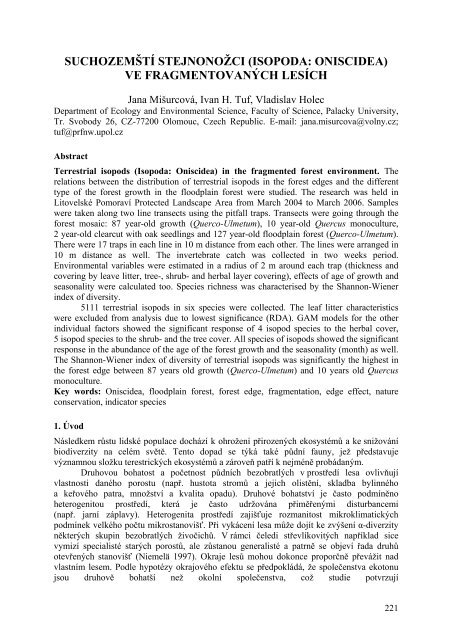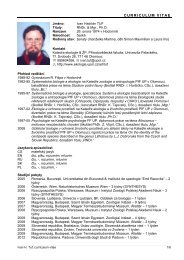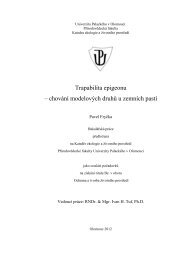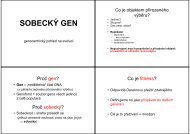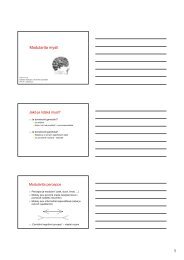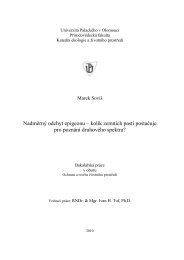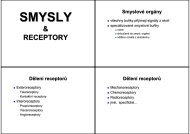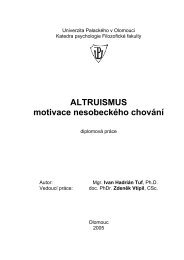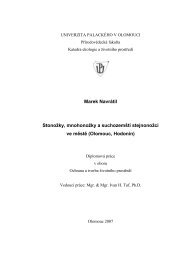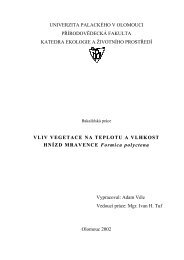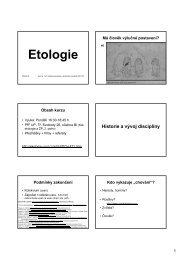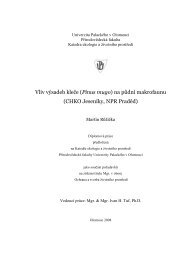opravená verze - Katedra ekologie a životního prostředí - Univerzita ...
opravená verze - Katedra ekologie a životního prostředí - Univerzita ...
opravená verze - Katedra ekologie a životního prostředí - Univerzita ...
Create successful ePaper yourself
Turn your PDF publications into a flip-book with our unique Google optimized e-Paper software.
SUCHOZEMŠTÍ STEJNONOŽCI (ISOPODA: ONISCIDEA)<br />
VE FRAGMENTOVANÝCH LESÍCH<br />
Jana Mišurcová, Ivan H. Tuf, Vladislav Holec<br />
Department of Ecology and Environmental Science, Faculty of Science, Palacky University,<br />
Tr. Svobody 26, CZ-77200 Olomouc, Czech Republic. E-mail: jana.misurcova@volny.cz;<br />
tuf@prfnw.upol.cz<br />
Abstract<br />
Terrestrial isopods (Isopoda: Oniscidea) in the fragmented forest environment. The<br />
relations between the distribution of terrestrial isopods in the forest edges and the different<br />
type of the forest growth in the floodplain forest were studied. The research was held in<br />
Litovelské Pomoraví Protected Landscape Area from March 2004 to March 2006. Samples<br />
were taken along two line transects using the pitfall traps. Transects were going through the<br />
forest mosaic: 87 year-old growth (Querco-Ulmetum), 10 year-old Quercus monoculture,<br />
2 year-old clearcut with oak seedlings and 127 year-old floodplain forest (Querco-Ulmetum).<br />
There were 17 traps in each line in 10 m distance from each other. The lines were arranged in<br />
10 m distance as well. The invertebrate catch was collected in two weeks period.<br />
Environmental variables were estimated in a radius of 2 m around each trap (thickness and<br />
covering by leave litter, tree-, shrub- and herbal layer covering), effects of age of growth and<br />
seasonality were calculated too. Species richness was characterised by the Shannon-Wiener<br />
index of diversity.<br />
5111 terrestrial isopods in six species were collected. The leaf litter characteristics<br />
were excluded from analysis due to lowest significance (RDA). GAM models for the other<br />
individual factors showed the significant response of 4 isopod species to the herbal cover,<br />
5 isopod species to the shrub- and the tree cover. All species of isopods showed the significant<br />
response in the abundance of the age of the forest growth and the seasonality (month) as well.<br />
The Shannon-Wiener index of diversity of terrestrial isopods was significantly the highest in<br />
the forest edge between 87 years old growth (Querco-Ulmetum) and 10 years old Quercus<br />
monoculture.<br />
Key words: Oniscidea, floodplain forest, forest edge, fragmentation, edge effect, nature<br />
conservation, indicator species<br />
1. Úvod<br />
Následkem růstu lidské populace dochází k ohrožení přirozených ekosystémů a ke snižování<br />
biodiverzity na celém světě. Tento dopad se týká také půdní fauny, jež představuje<br />
významnou složku terestrických ekosystémů a zároveň patří k nejméně probádaným.<br />
Druhovou bohatost a početnost půdních bezobratlých v <strong>prostředí</strong> lesa ovlivňují<br />
vlastnosti daného porostu (např. hustota stromů a jejich olistění, skladba bylinného<br />
a keřového patra, množství a kvalita opadu). Druhové bohatství je často podmíněno<br />
heterogenitou <strong>prostředí</strong>, která je často udržována přiměřenými disturbancemi<br />
(např. jarní záplavy). Heterogenita <strong>prostředí</strong> zajišťuje rozmanitost mikroklimatických<br />
podmínek velkého počtu mikrostanovišť. Při vykácení lesa může dojít ke zvýšení α-diverzity<br />
některých skupin bezobratlých živočichů. V rámci čeledi střevlíkovitých například sice<br />
vymizí specialisté starých porostů, ale zůstanou generalisté a patrně se objeví řada druhů<br />
otevřených stanovišť (Niemelä 1997). Okraje lesů mohou dokonce proporčně převážit nad<br />
vlastním lesem. Podle hypotézy okrajového efektu se předpokládá, že společenstva ekotonu<br />
jsou druhově bohatší než okolní společenstva, což studie potvrzují<br />
221


